Business Development: Source Evaluation Checklist Assignment Analysis
VerifiedAdded on 2020/01/06
|9
|2337
|420
Homework Assignment
AI Summary
This assignment presents a source evaluation checklist applied to four different academic sources. Each source undergoes a detailed analysis, assessing its credibility by examining author credentials, publisher reputation, and peer-review status. The currency of each source is evaluated by considering its publication date and relevance to the subject matter. The perspective or bias of the authors is considered, determining whether the source's purpose is to inform, persuade, or entertain. Accuracy is determined by checking for factual support, citations, and a references list. The assignment analyzes sources including Chaminade & De Fuentes (2012), Hirst, Thompson & Bromley (2015), Mak, Lumbers & Eves (2012), and Tiwari & Herstatt (2012), offering a comprehensive evaluation of each source's strengths and weaknesses for academic use. This analysis provides valuable insights into the reliability and applicability of each source for research purposes.
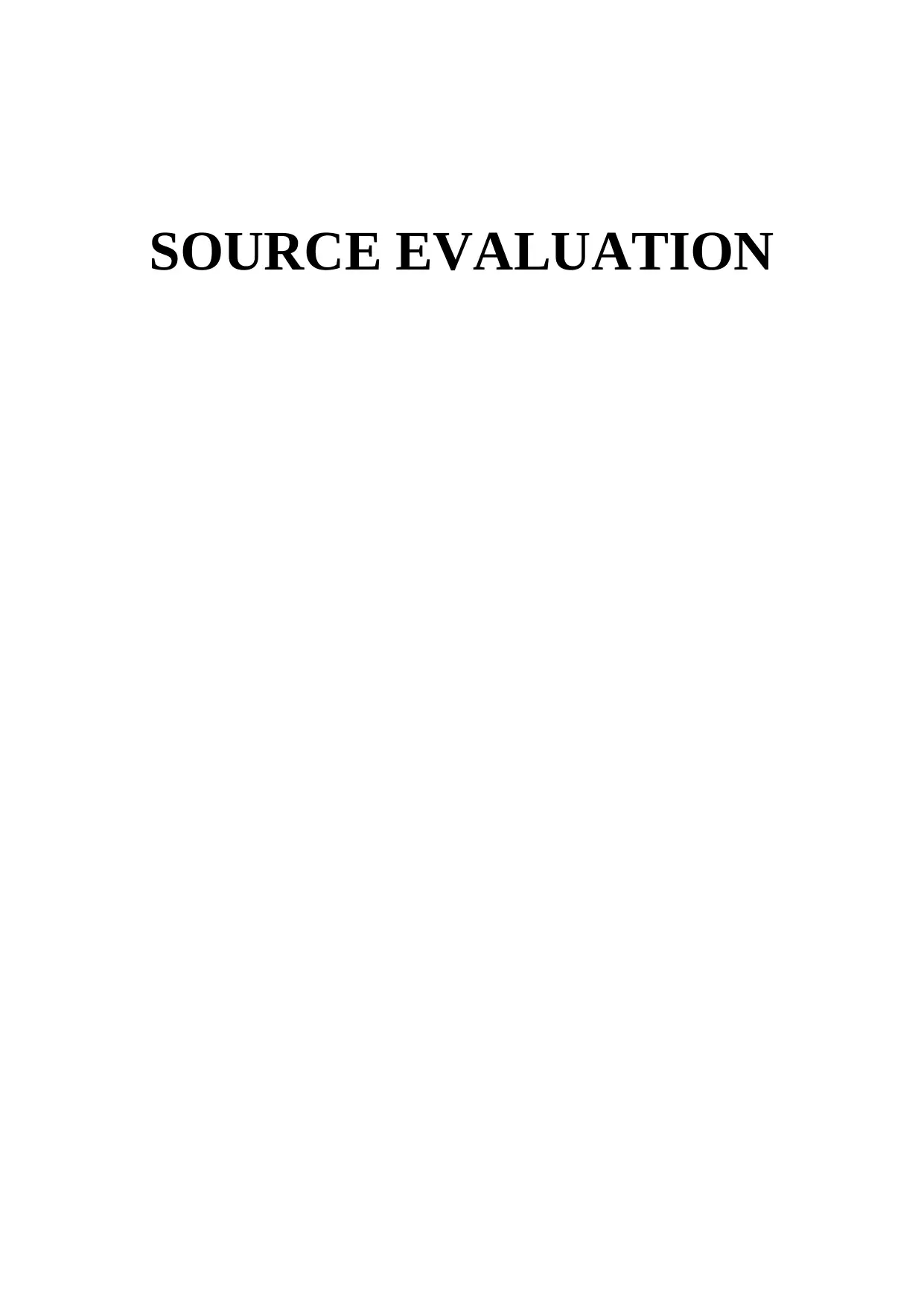
SOURCE EVALUATION
Paraphrase This Document
Need a fresh take? Get an instant paraphrase of this document with our AI Paraphraser
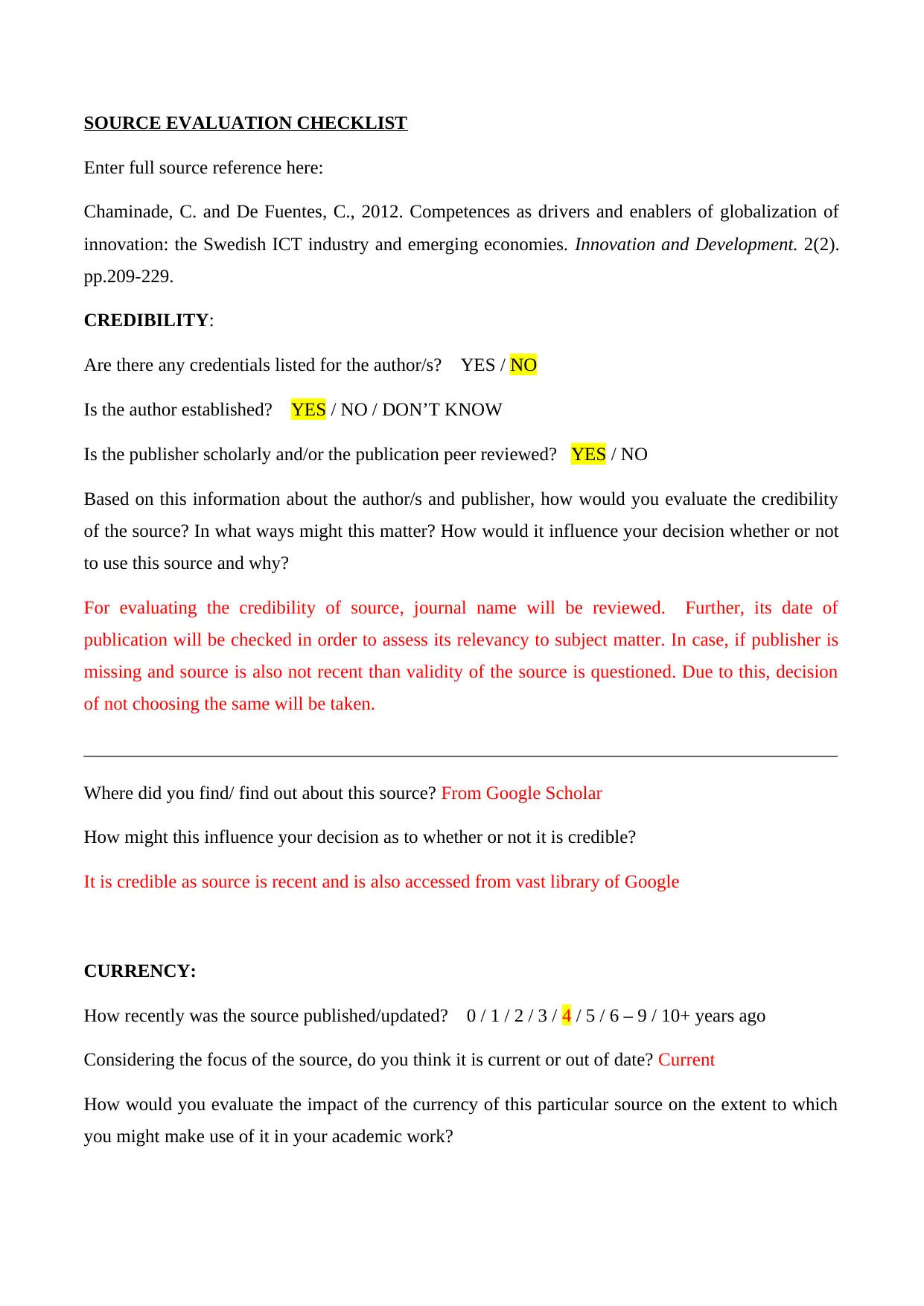
SOURCE EVALUATION CHECKLIST
Enter full source reference here:
Chaminade, C. and De Fuentes, C., 2012. Competences as drivers and enablers of globalization of
innovation: the Swedish ICT industry and emerging economies. Innovation and Development. 2(2).
pp.209-229.
CREDIBILITY:
Are there any credentials listed for the author/s? YES / NO
Is the author established? YES / NO / DON’T KNOW
Is the publisher scholarly and/or the publication peer reviewed? YES / NO
Based on this information about the author/s and publisher, how would you evaluate the credibility
of the source? In what ways might this matter? How would it influence your decision whether or not
to use this source and why?
For evaluating the credibility of source, journal name will be reviewed. Further, its date of
publication will be checked in order to assess its relevancy to subject matter. In case, if publisher is
missing and source is also not recent than validity of the source is questioned. Due to this, decision
of not choosing the same will be taken.
_________________________________________________________________________________
Where did you find/ find out about this source? From Google Scholar
How might this influence your decision as to whether or not it is credible?
It is credible as source is recent and is also accessed from vast library of Google
CURRENCY:
How recently was the source published/updated? 0 / 1 / 2 / 3 / 4 / 5 / 6 – 9 / 10+ years ago
Considering the focus of the source, do you think it is current or out of date? Current
How would you evaluate the impact of the currency of this particular source on the extent to which
you might make use of it in your academic work?
Enter full source reference here:
Chaminade, C. and De Fuentes, C., 2012. Competences as drivers and enablers of globalization of
innovation: the Swedish ICT industry and emerging economies. Innovation and Development. 2(2).
pp.209-229.
CREDIBILITY:
Are there any credentials listed for the author/s? YES / NO
Is the author established? YES / NO / DON’T KNOW
Is the publisher scholarly and/or the publication peer reviewed? YES / NO
Based on this information about the author/s and publisher, how would you evaluate the credibility
of the source? In what ways might this matter? How would it influence your decision whether or not
to use this source and why?
For evaluating the credibility of source, journal name will be reviewed. Further, its date of
publication will be checked in order to assess its relevancy to subject matter. In case, if publisher is
missing and source is also not recent than validity of the source is questioned. Due to this, decision
of not choosing the same will be taken.
_________________________________________________________________________________
Where did you find/ find out about this source? From Google Scholar
How might this influence your decision as to whether or not it is credible?
It is credible as source is recent and is also accessed from vast library of Google
CURRENCY:
How recently was the source published/updated? 0 / 1 / 2 / 3 / 4 / 5 / 6 – 9 / 10+ years ago
Considering the focus of the source, do you think it is current or out of date? Current
How would you evaluate the impact of the currency of this particular source on the extent to which
you might make use of it in your academic work?
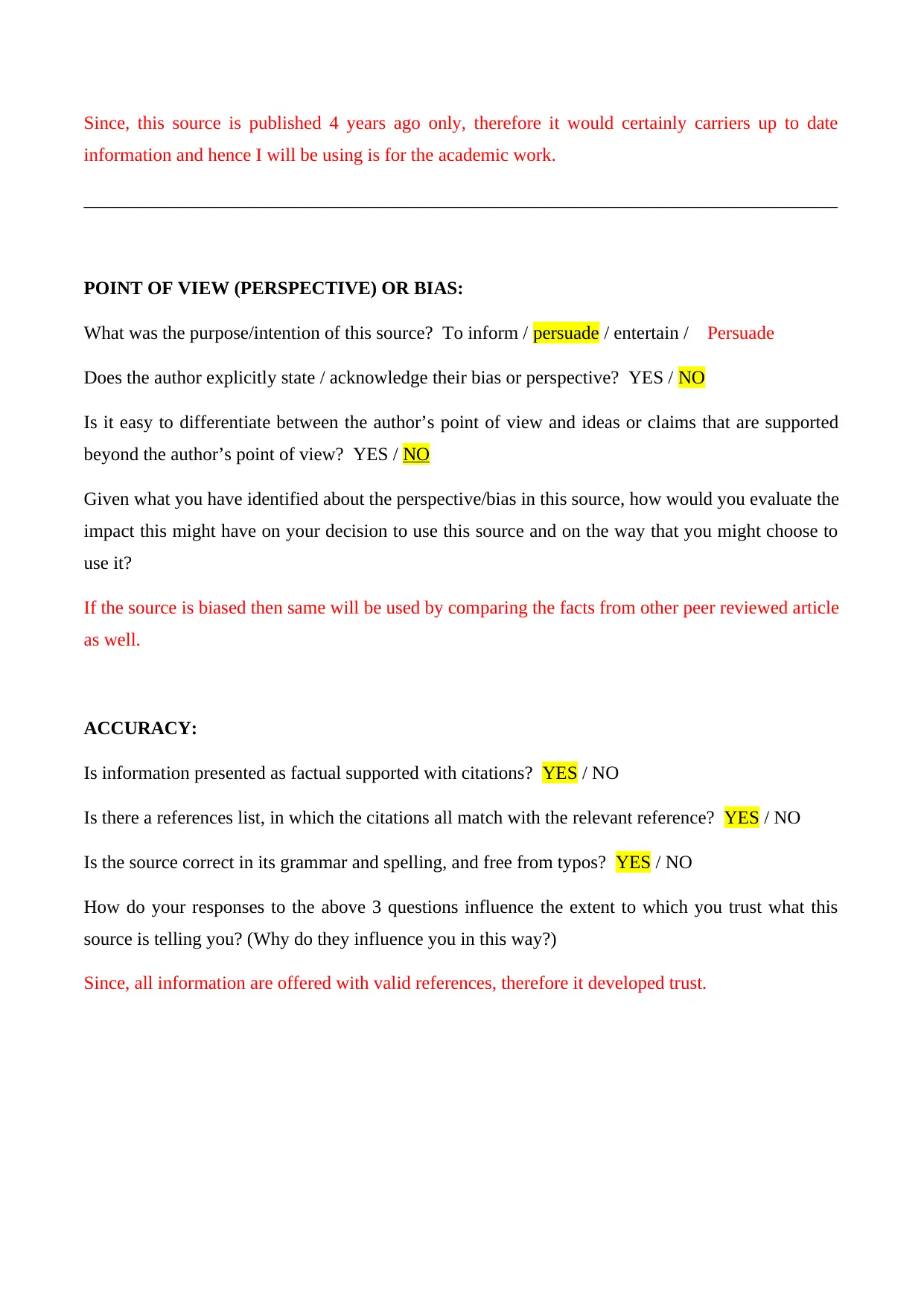
Since, this source is published 4 years ago only, therefore it would certainly carriers up to date
information and hence I will be using is for the academic work.
_________________________________________________________________________________
POINT OF VIEW (PERSPECTIVE) OR BIAS:
What was the purpose/intention of this source? To inform / persuade / entertain / Persuade
Does the author explicitly state / acknowledge their bias or perspective? YES / NO
Is it easy to differentiate between the author’s point of view and ideas or claims that are supported
beyond the author’s point of view? YES / NO
Given what you have identified about the perspective/bias in this source, how would you evaluate the
impact this might have on your decision to use this source and on the way that you might choose to
use it?
If the source is biased then same will be used by comparing the facts from other peer reviewed article
as well.
ACCURACY:
Is information presented as factual supported with citations? YES / NO
Is there a references list, in which the citations all match with the relevant reference? YES / NO
Is the source correct in its grammar and spelling, and free from typos? YES / NO
How do your responses to the above 3 questions influence the extent to which you trust what this
source is telling you? (Why do they influence you in this way?)
Since, all information are offered with valid references, therefore it developed trust.
information and hence I will be using is for the academic work.
_________________________________________________________________________________
POINT OF VIEW (PERSPECTIVE) OR BIAS:
What was the purpose/intention of this source? To inform / persuade / entertain / Persuade
Does the author explicitly state / acknowledge their bias or perspective? YES / NO
Is it easy to differentiate between the author’s point of view and ideas or claims that are supported
beyond the author’s point of view? YES / NO
Given what you have identified about the perspective/bias in this source, how would you evaluate the
impact this might have on your decision to use this source and on the way that you might choose to
use it?
If the source is biased then same will be used by comparing the facts from other peer reviewed article
as well.
ACCURACY:
Is information presented as factual supported with citations? YES / NO
Is there a references list, in which the citations all match with the relevant reference? YES / NO
Is the source correct in its grammar and spelling, and free from typos? YES / NO
How do your responses to the above 3 questions influence the extent to which you trust what this
source is telling you? (Why do they influence you in this way?)
Since, all information are offered with valid references, therefore it developed trust.
⊘ This is a preview!⊘
Do you want full access?
Subscribe today to unlock all pages.

Trusted by 1+ million students worldwide
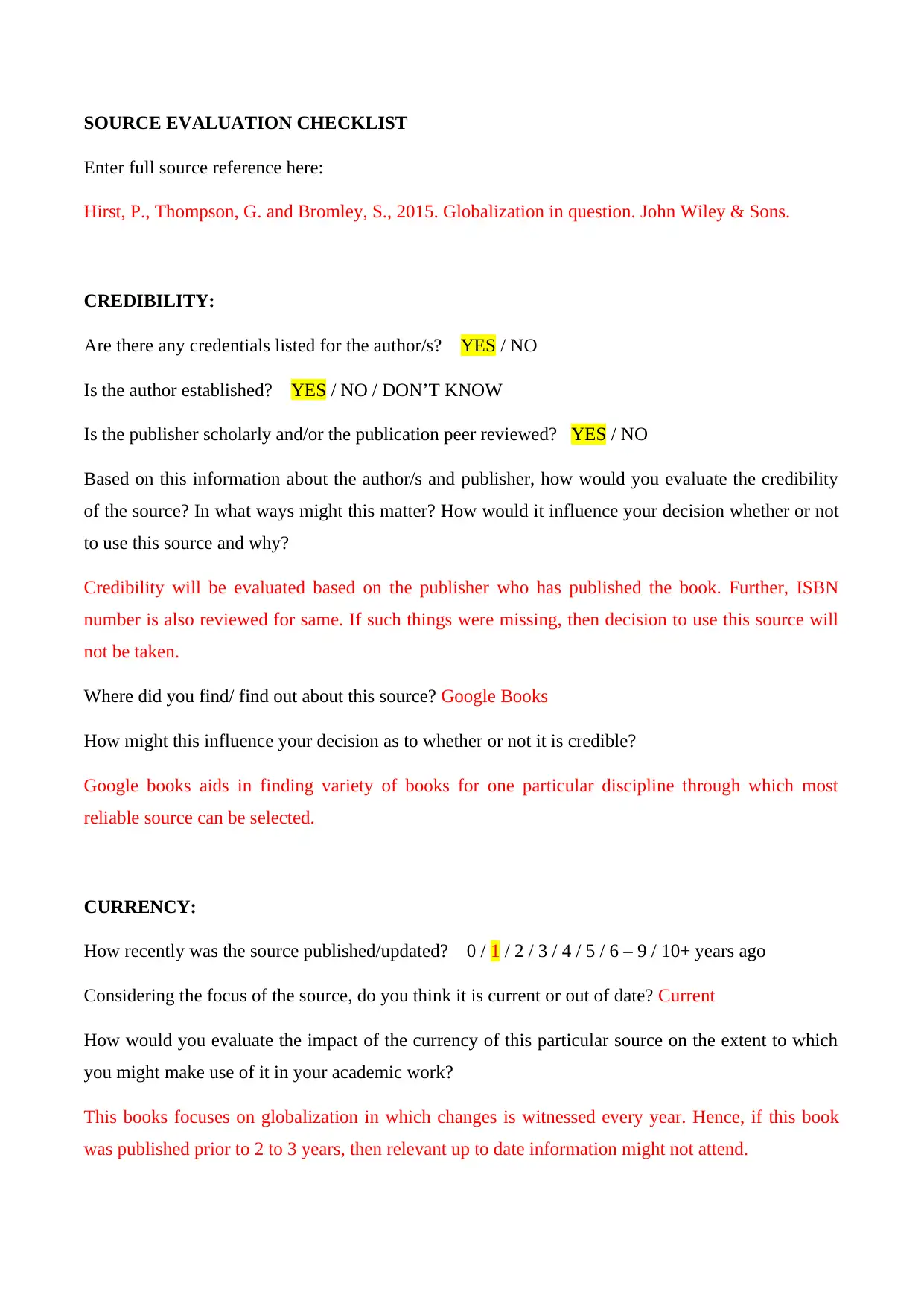
SOURCE EVALUATION CHECKLIST
Enter full source reference here:
Hirst, P., Thompson, G. and Bromley, S., 2015. Globalization in question. John Wiley & Sons.
CREDIBILITY:
Are there any credentials listed for the author/s? YES / NO
Is the author established? YES / NO / DON’T KNOW
Is the publisher scholarly and/or the publication peer reviewed? YES / NO
Based on this information about the author/s and publisher, how would you evaluate the credibility
of the source? In what ways might this matter? How would it influence your decision whether or not
to use this source and why?
Credibility will be evaluated based on the publisher who has published the book. Further, ISBN
number is also reviewed for same. If such things were missing, then decision to use this source will
not be taken.
Where did you find/ find out about this source? Google Books
How might this influence your decision as to whether or not it is credible?
Google books aids in finding variety of books for one particular discipline through which most
reliable source can be selected.
CURRENCY:
How recently was the source published/updated? 0 / 1 / 2 / 3 / 4 / 5 / 6 – 9 / 10+ years ago
Considering the focus of the source, do you think it is current or out of date? Current
How would you evaluate the impact of the currency of this particular source on the extent to which
you might make use of it in your academic work?
This books focuses on globalization in which changes is witnessed every year. Hence, if this book
was published prior to 2 to 3 years, then relevant up to date information might not attend.
Enter full source reference here:
Hirst, P., Thompson, G. and Bromley, S., 2015. Globalization in question. John Wiley & Sons.
CREDIBILITY:
Are there any credentials listed for the author/s? YES / NO
Is the author established? YES / NO / DON’T KNOW
Is the publisher scholarly and/or the publication peer reviewed? YES / NO
Based on this information about the author/s and publisher, how would you evaluate the credibility
of the source? In what ways might this matter? How would it influence your decision whether or not
to use this source and why?
Credibility will be evaluated based on the publisher who has published the book. Further, ISBN
number is also reviewed for same. If such things were missing, then decision to use this source will
not be taken.
Where did you find/ find out about this source? Google Books
How might this influence your decision as to whether or not it is credible?
Google books aids in finding variety of books for one particular discipline through which most
reliable source can be selected.
CURRENCY:
How recently was the source published/updated? 0 / 1 / 2 / 3 / 4 / 5 / 6 – 9 / 10+ years ago
Considering the focus of the source, do you think it is current or out of date? Current
How would you evaluate the impact of the currency of this particular source on the extent to which
you might make use of it in your academic work?
This books focuses on globalization in which changes is witnessed every year. Hence, if this book
was published prior to 2 to 3 years, then relevant up to date information might not attend.
Paraphrase This Document
Need a fresh take? Get an instant paraphrase of this document with our AI Paraphraser
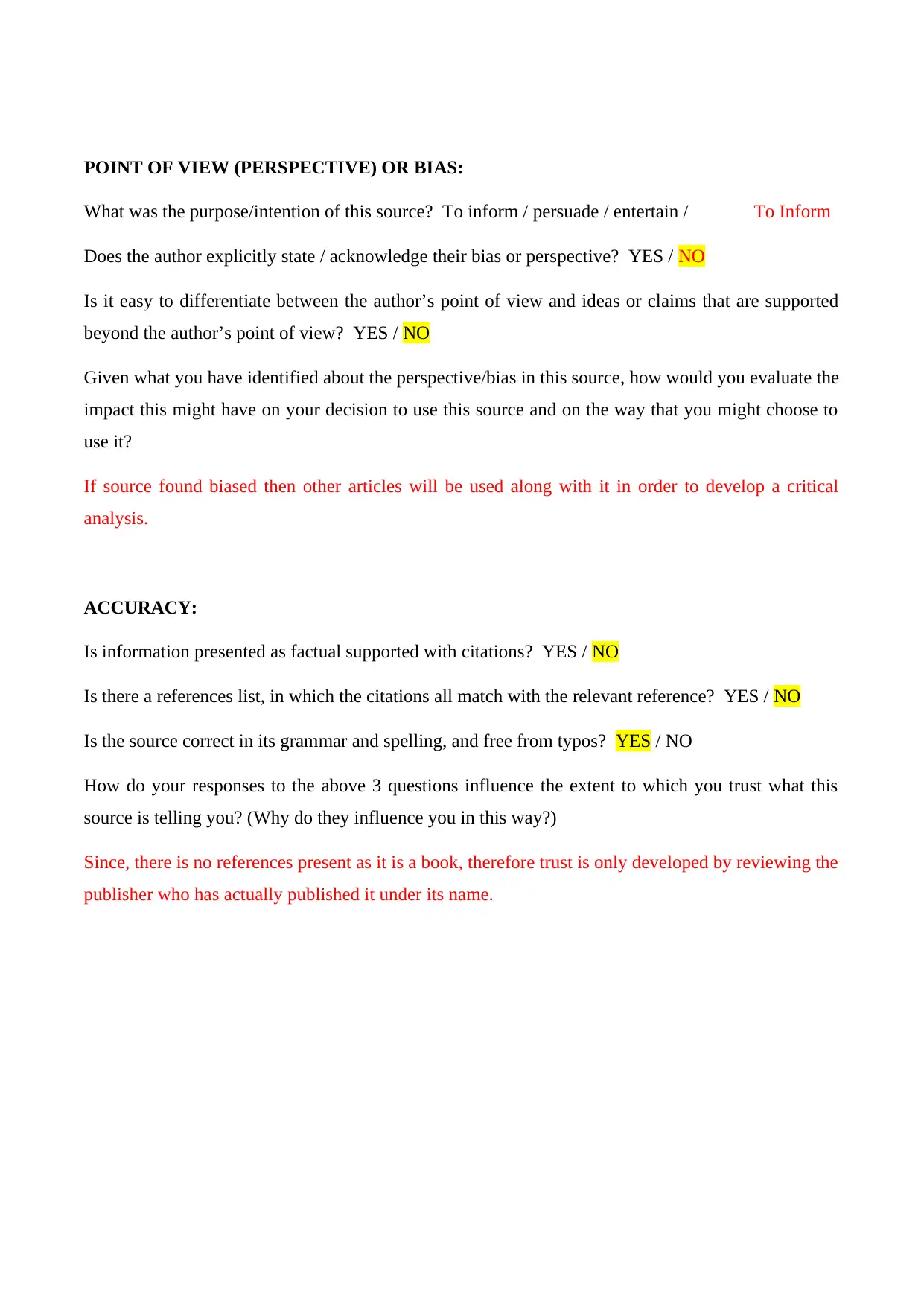
POINT OF VIEW (PERSPECTIVE) OR BIAS:
What was the purpose/intention of this source? To inform / persuade / entertain / To Inform
Does the author explicitly state / acknowledge their bias or perspective? YES / NO
Is it easy to differentiate between the author’s point of view and ideas or claims that are supported
beyond the author’s point of view? YES / NO
Given what you have identified about the perspective/bias in this source, how would you evaluate the
impact this might have on your decision to use this source and on the way that you might choose to
use it?
If source found biased then other articles will be used along with it in order to develop a critical
analysis.
ACCURACY:
Is information presented as factual supported with citations? YES / NO
Is there a references list, in which the citations all match with the relevant reference? YES / NO
Is the source correct in its grammar and spelling, and free from typos? YES / NO
How do your responses to the above 3 questions influence the extent to which you trust what this
source is telling you? (Why do they influence you in this way?)
Since, there is no references present as it is a book, therefore trust is only developed by reviewing the
publisher who has actually published it under its name.
What was the purpose/intention of this source? To inform / persuade / entertain / To Inform
Does the author explicitly state / acknowledge their bias or perspective? YES / NO
Is it easy to differentiate between the author’s point of view and ideas or claims that are supported
beyond the author’s point of view? YES / NO
Given what you have identified about the perspective/bias in this source, how would you evaluate the
impact this might have on your decision to use this source and on the way that you might choose to
use it?
If source found biased then other articles will be used along with it in order to develop a critical
analysis.
ACCURACY:
Is information presented as factual supported with citations? YES / NO
Is there a references list, in which the citations all match with the relevant reference? YES / NO
Is the source correct in its grammar and spelling, and free from typos? YES / NO
How do your responses to the above 3 questions influence the extent to which you trust what this
source is telling you? (Why do they influence you in this way?)
Since, there is no references present as it is a book, therefore trust is only developed by reviewing the
publisher who has actually published it under its name.
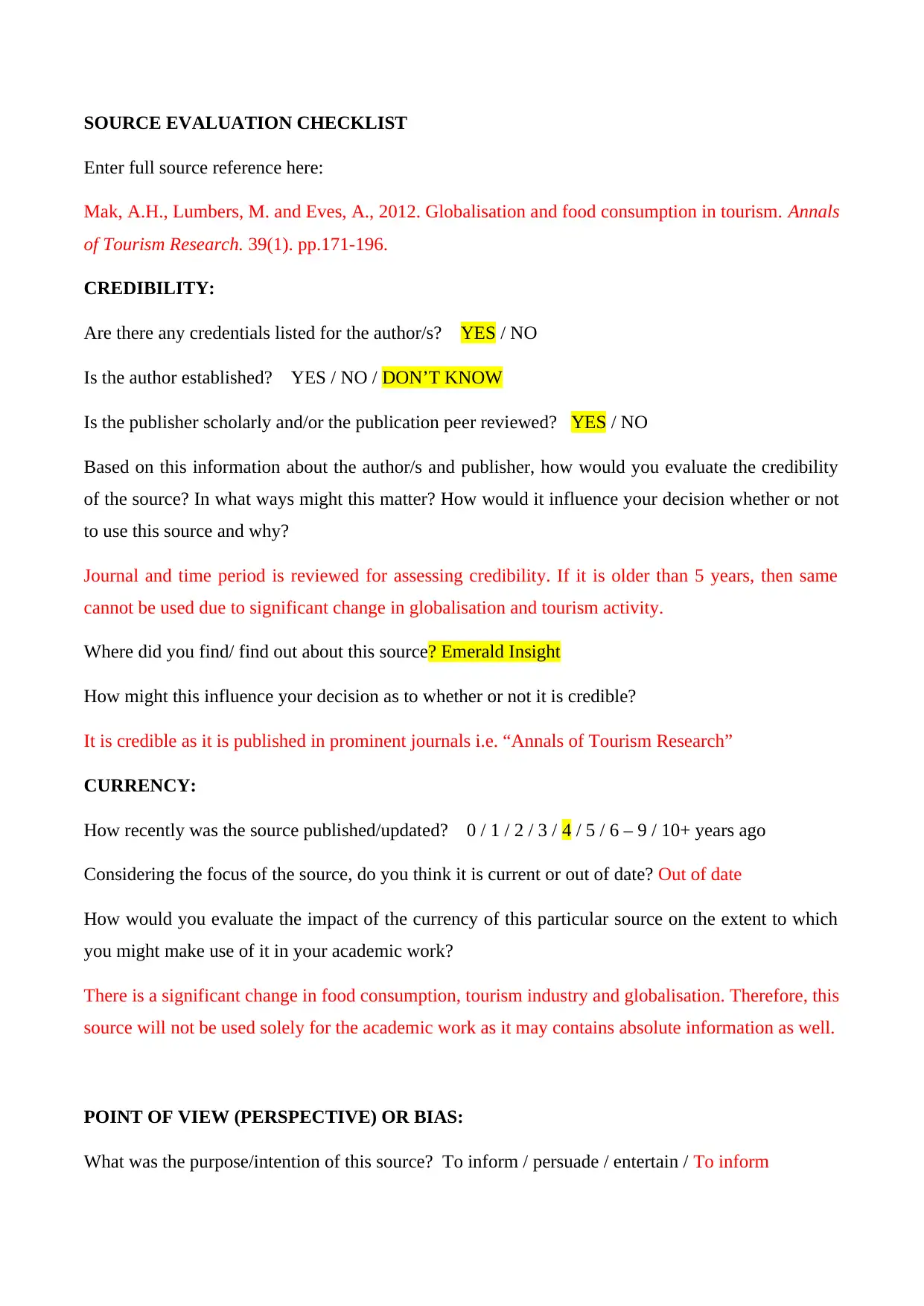
SOURCE EVALUATION CHECKLIST
Enter full source reference here:
Mak, A.H., Lumbers, M. and Eves, A., 2012. Globalisation and food consumption in tourism. Annals
of Tourism Research. 39(1). pp.171-196.
CREDIBILITY:
Are there any credentials listed for the author/s? YES / NO
Is the author established? YES / NO / DON’T KNOW
Is the publisher scholarly and/or the publication peer reviewed? YES / NO
Based on this information about the author/s and publisher, how would you evaluate the credibility
of the source? In what ways might this matter? How would it influence your decision whether or not
to use this source and why?
Journal and time period is reviewed for assessing credibility. If it is older than 5 years, then same
cannot be used due to significant change in globalisation and tourism activity.
Where did you find/ find out about this source? Emerald Insight
How might this influence your decision as to whether or not it is credible?
It is credible as it is published in prominent journals i.e. “Annals of Tourism Research”
CURRENCY:
How recently was the source published/updated? 0 / 1 / 2 / 3 / 4 / 5 / 6 – 9 / 10+ years ago
Considering the focus of the source, do you think it is current or out of date? Out of date
How would you evaluate the impact of the currency of this particular source on the extent to which
you might make use of it in your academic work?
There is a significant change in food consumption, tourism industry and globalisation. Therefore, this
source will not be used solely for the academic work as it may contains absolute information as well.
POINT OF VIEW (PERSPECTIVE) OR BIAS:
What was the purpose/intention of this source? To inform / persuade / entertain / To inform
Enter full source reference here:
Mak, A.H., Lumbers, M. and Eves, A., 2012. Globalisation and food consumption in tourism. Annals
of Tourism Research. 39(1). pp.171-196.
CREDIBILITY:
Are there any credentials listed for the author/s? YES / NO
Is the author established? YES / NO / DON’T KNOW
Is the publisher scholarly and/or the publication peer reviewed? YES / NO
Based on this information about the author/s and publisher, how would you evaluate the credibility
of the source? In what ways might this matter? How would it influence your decision whether or not
to use this source and why?
Journal and time period is reviewed for assessing credibility. If it is older than 5 years, then same
cannot be used due to significant change in globalisation and tourism activity.
Where did you find/ find out about this source? Emerald Insight
How might this influence your decision as to whether or not it is credible?
It is credible as it is published in prominent journals i.e. “Annals of Tourism Research”
CURRENCY:
How recently was the source published/updated? 0 / 1 / 2 / 3 / 4 / 5 / 6 – 9 / 10+ years ago
Considering the focus of the source, do you think it is current or out of date? Out of date
How would you evaluate the impact of the currency of this particular source on the extent to which
you might make use of it in your academic work?
There is a significant change in food consumption, tourism industry and globalisation. Therefore, this
source will not be used solely for the academic work as it may contains absolute information as well.
POINT OF VIEW (PERSPECTIVE) OR BIAS:
What was the purpose/intention of this source? To inform / persuade / entertain / To inform
⊘ This is a preview!⊘
Do you want full access?
Subscribe today to unlock all pages.

Trusted by 1+ million students worldwide
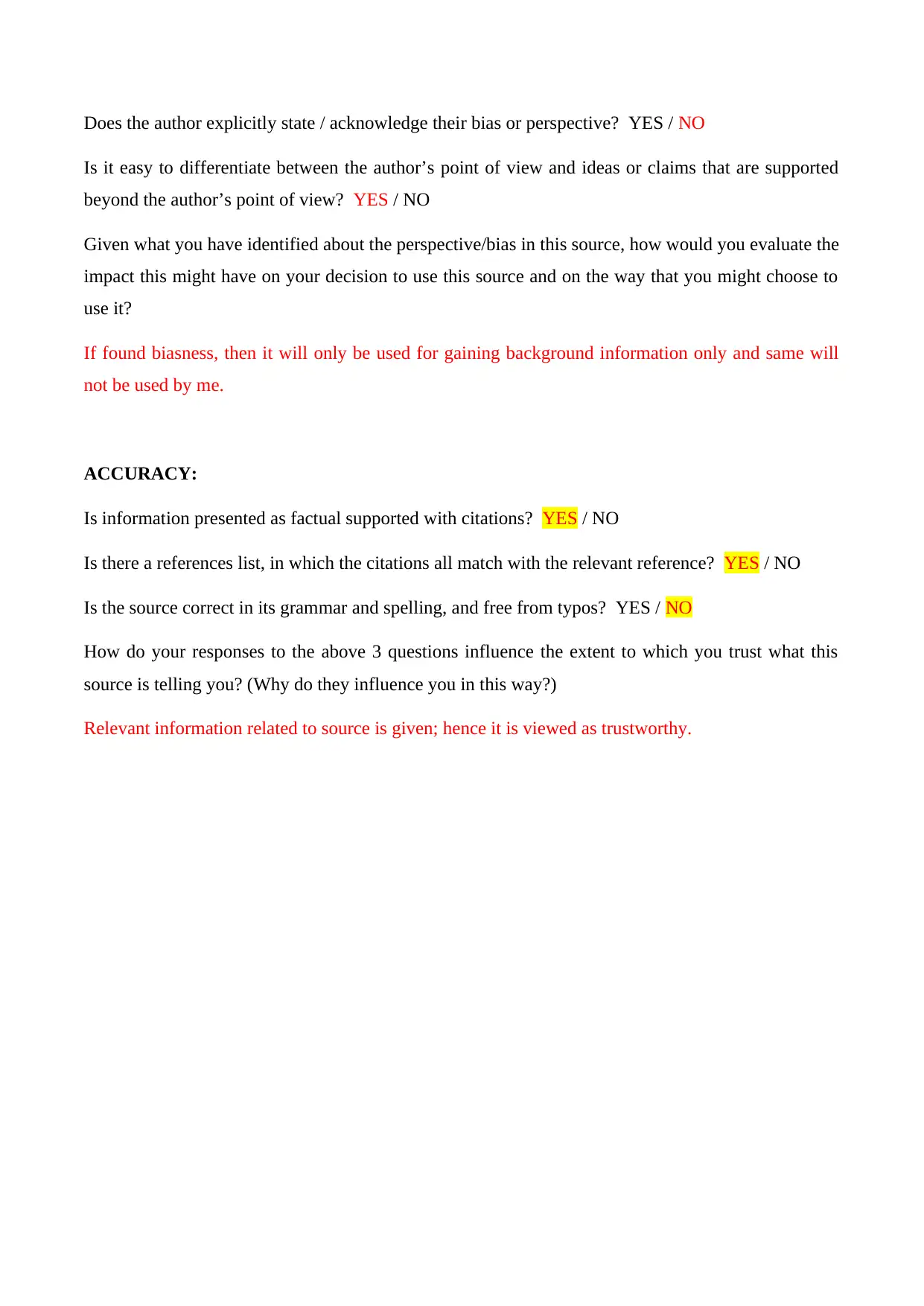
Does the author explicitly state / acknowledge their bias or perspective? YES / NO
Is it easy to differentiate between the author’s point of view and ideas or claims that are supported
beyond the author’s point of view? YES / NO
Given what you have identified about the perspective/bias in this source, how would you evaluate the
impact this might have on your decision to use this source and on the way that you might choose to
use it?
If found biasness, then it will only be used for gaining background information only and same will
not be used by me.
ACCURACY:
Is information presented as factual supported with citations? YES / NO
Is there a references list, in which the citations all match with the relevant reference? YES / NO
Is the source correct in its grammar and spelling, and free from typos? YES / NO
How do your responses to the above 3 questions influence the extent to which you trust what this
source is telling you? (Why do they influence you in this way?)
Relevant information related to source is given; hence it is viewed as trustworthy.
Is it easy to differentiate between the author’s point of view and ideas or claims that are supported
beyond the author’s point of view? YES / NO
Given what you have identified about the perspective/bias in this source, how would you evaluate the
impact this might have on your decision to use this source and on the way that you might choose to
use it?
If found biasness, then it will only be used for gaining background information only and same will
not be used by me.
ACCURACY:
Is information presented as factual supported with citations? YES / NO
Is there a references list, in which the citations all match with the relevant reference? YES / NO
Is the source correct in its grammar and spelling, and free from typos? YES / NO
How do your responses to the above 3 questions influence the extent to which you trust what this
source is telling you? (Why do they influence you in this way?)
Relevant information related to source is given; hence it is viewed as trustworthy.
Paraphrase This Document
Need a fresh take? Get an instant paraphrase of this document with our AI Paraphraser
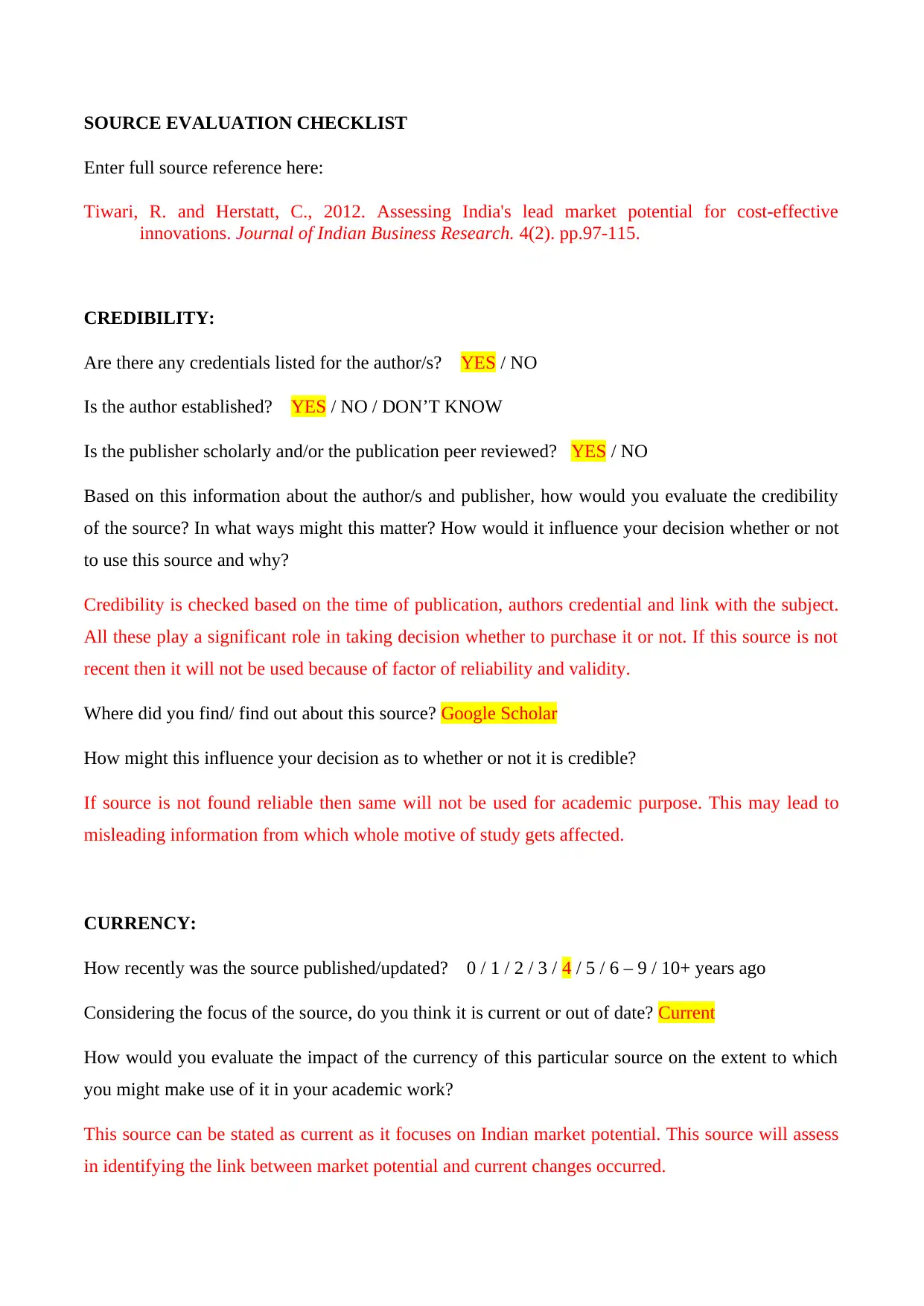
SOURCE EVALUATION CHECKLIST
Enter full source reference here:
Tiwari, R. and Herstatt, C., 2012. Assessing India's lead market potential for cost-effective
innovations. Journal of Indian Business Research. 4(2). pp.97-115.
CREDIBILITY:
Are there any credentials listed for the author/s? YES / NO
Is the author established? YES / NO / DON’T KNOW
Is the publisher scholarly and/or the publication peer reviewed? YES / NO
Based on this information about the author/s and publisher, how would you evaluate the credibility
of the source? In what ways might this matter? How would it influence your decision whether or not
to use this source and why?
Credibility is checked based on the time of publication, authors credential and link with the subject.
All these play a significant role in taking decision whether to purchase it or not. If this source is not
recent then it will not be used because of factor of reliability and validity.
Where did you find/ find out about this source? Google Scholar
How might this influence your decision as to whether or not it is credible?
If source is not found reliable then same will not be used for academic purpose. This may lead to
misleading information from which whole motive of study gets affected.
CURRENCY:
How recently was the source published/updated? 0 / 1 / 2 / 3 / 4 / 5 / 6 – 9 / 10+ years ago
Considering the focus of the source, do you think it is current or out of date? Current
How would you evaluate the impact of the currency of this particular source on the extent to which
you might make use of it in your academic work?
This source can be stated as current as it focuses on Indian market potential. This source will assess
in identifying the link between market potential and current changes occurred.
Enter full source reference here:
Tiwari, R. and Herstatt, C., 2012. Assessing India's lead market potential for cost-effective
innovations. Journal of Indian Business Research. 4(2). pp.97-115.
CREDIBILITY:
Are there any credentials listed for the author/s? YES / NO
Is the author established? YES / NO / DON’T KNOW
Is the publisher scholarly and/or the publication peer reviewed? YES / NO
Based on this information about the author/s and publisher, how would you evaluate the credibility
of the source? In what ways might this matter? How would it influence your decision whether or not
to use this source and why?
Credibility is checked based on the time of publication, authors credential and link with the subject.
All these play a significant role in taking decision whether to purchase it or not. If this source is not
recent then it will not be used because of factor of reliability and validity.
Where did you find/ find out about this source? Google Scholar
How might this influence your decision as to whether or not it is credible?
If source is not found reliable then same will not be used for academic purpose. This may lead to
misleading information from which whole motive of study gets affected.
CURRENCY:
How recently was the source published/updated? 0 / 1 / 2 / 3 / 4 / 5 / 6 – 9 / 10+ years ago
Considering the focus of the source, do you think it is current or out of date? Current
How would you evaluate the impact of the currency of this particular source on the extent to which
you might make use of it in your academic work?
This source can be stated as current as it focuses on Indian market potential. This source will assess
in identifying the link between market potential and current changes occurred.
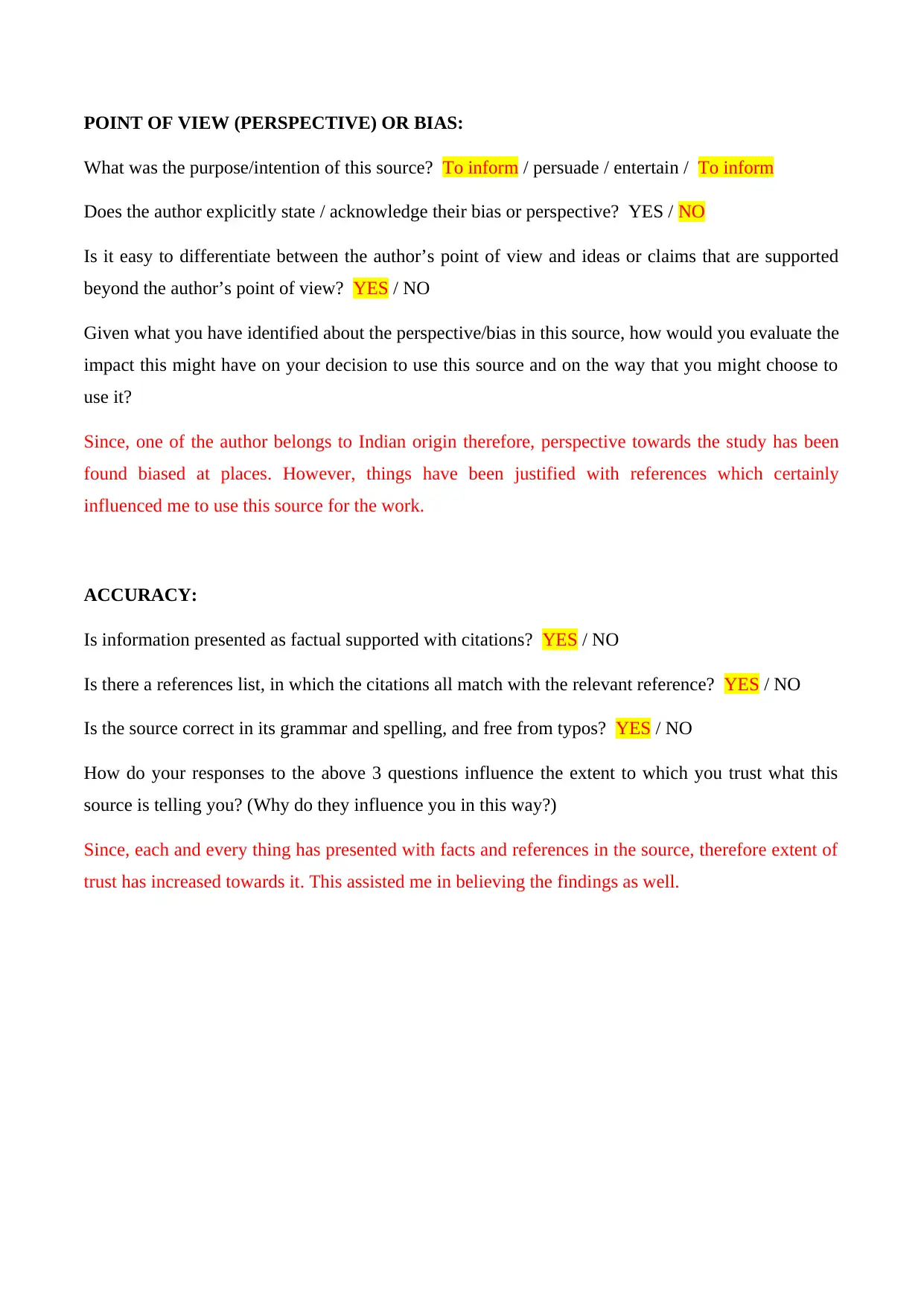
POINT OF VIEW (PERSPECTIVE) OR BIAS:
What was the purpose/intention of this source? To inform / persuade / entertain / To inform
Does the author explicitly state / acknowledge their bias or perspective? YES / NO
Is it easy to differentiate between the author’s point of view and ideas or claims that are supported
beyond the author’s point of view? YES / NO
Given what you have identified about the perspective/bias in this source, how would you evaluate the
impact this might have on your decision to use this source and on the way that you might choose to
use it?
Since, one of the author belongs to Indian origin therefore, perspective towards the study has been
found biased at places. However, things have been justified with references which certainly
influenced me to use this source for the work.
ACCURACY:
Is information presented as factual supported with citations? YES / NO
Is there a references list, in which the citations all match with the relevant reference? YES / NO
Is the source correct in its grammar and spelling, and free from typos? YES / NO
How do your responses to the above 3 questions influence the extent to which you trust what this
source is telling you? (Why do they influence you in this way?)
Since, each and every thing has presented with facts and references in the source, therefore extent of
trust has increased towards it. This assisted me in believing the findings as well.
What was the purpose/intention of this source? To inform / persuade / entertain / To inform
Does the author explicitly state / acknowledge their bias or perspective? YES / NO
Is it easy to differentiate between the author’s point of view and ideas or claims that are supported
beyond the author’s point of view? YES / NO
Given what you have identified about the perspective/bias in this source, how would you evaluate the
impact this might have on your decision to use this source and on the way that you might choose to
use it?
Since, one of the author belongs to Indian origin therefore, perspective towards the study has been
found biased at places. However, things have been justified with references which certainly
influenced me to use this source for the work.
ACCURACY:
Is information presented as factual supported with citations? YES / NO
Is there a references list, in which the citations all match with the relevant reference? YES / NO
Is the source correct in its grammar and spelling, and free from typos? YES / NO
How do your responses to the above 3 questions influence the extent to which you trust what this
source is telling you? (Why do they influence you in this way?)
Since, each and every thing has presented with facts and references in the source, therefore extent of
trust has increased towards it. This assisted me in believing the findings as well.
⊘ This is a preview!⊘
Do you want full access?
Subscribe today to unlock all pages.

Trusted by 1+ million students worldwide
1 out of 9
Related Documents
Your All-in-One AI-Powered Toolkit for Academic Success.
+13062052269
info@desklib.com
Available 24*7 on WhatsApp / Email
![[object Object]](/_next/static/media/star-bottom.7253800d.svg)
Unlock your academic potential
Copyright © 2020–2025 A2Z Services. All Rights Reserved. Developed and managed by ZUCOL.




